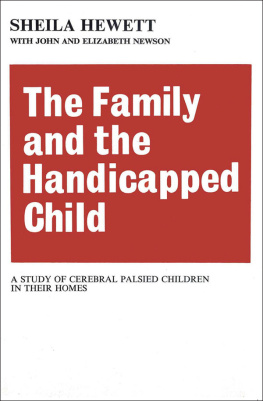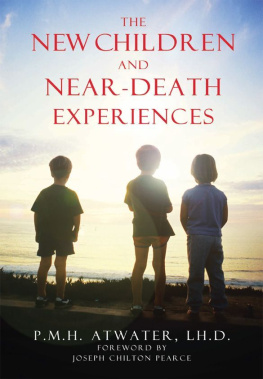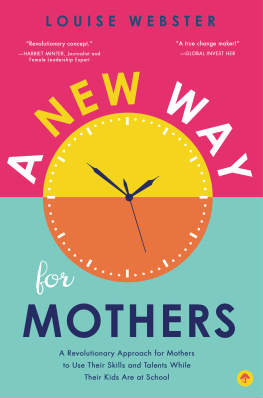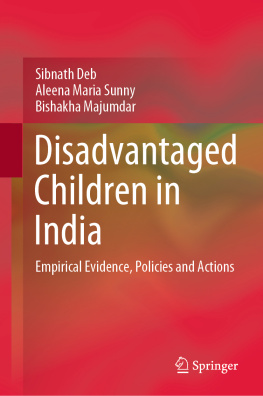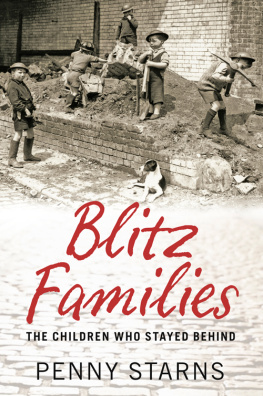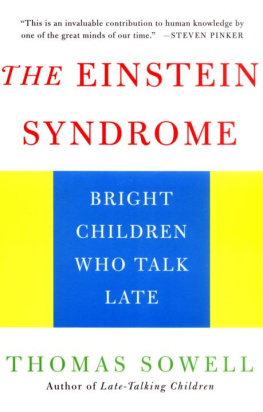First published 1970 by Transaction Publishers
Published 2017 by Routledge
2 Park Square, Milton Park, Abingdon, Oxon 0X14 4RN
711 Third Avenue, New York, NY 10017, USA
Routledge is an imprint of the Taylor & Francis Group, an informa business
Copyright 1970 by Taylor & Francis.
All rights reserved. No part of this book may be reprinted or reproduced or utilised in any form or by any electronic, mechanical, or other means, now known or hereafter invented, including photocopying and recording, or in any information storage or retrieval system, without permission in writing from the publishers.
Notice:
Product or corporate names may be trademarks or registered trademarks, and are used only for identification and explanation without intent to infringe.
Library of Congress Catalog Number: 2007015177
Library of Congress Cataloging-in-Publication Data
Hewett, Shelia.
Family and the handicapped child : a study of cerebral palsied children
in their homes / Shelia Hewett, with John and Elizabeth Newson.
p. cm.
Originally published: Chicago : Aldine Pub. Co., 1970.
Includes bibliographical references and index.
ISBN 978-0-202-30951-4 (alk. paper)
1. Cerebral palsied childrenHome care. I. Newson, John, 1925
II. Newson, Elizabeth, 1929- III. Title.
RJ496.C4H48 2007
618.92836dc22
2007015177
ISBN 13: 978-0-202-30951-4 (pbk)
Acknowledgements
We would like to express our gratitude for the help we received, in the early stages of this study, from Professor Jack Tizard, Lady Jessie Francis-Williams, Dr. Agatha Bowley and Dr. M. L. Kellmer-Pringle, all of whom willingly shared with us their expertise and experience in child development and research.
We are also indebted to the staff of the Spastics Society Family Help Unit in Nottingham, not only for making it possible for us to obtain our sample but also for welcoming us to the Unit at all times, so that we could learn at first hand something about cerebral palsied children.
Our thanks also to Jean Crossland for her assistance with the field work and particularly for her secretarial services.
This study would not have been possible without the financial support of the Spastics Society, and we would particularly like to thank the Societys director, Mr. James Loring, for his interest We must emphasise, however, that any opinions expressed in this book are entirely our own and are not necessarily shared by the Society.
Finally, to the mothers who so willingly gave us their time and the benefit of their experience, we offer our warmest thanks. Much of the content of this volume is in their words and it is to them and to their children that we dedicate our book.
This book is a report of a research project which was designed to do three things: first, to discover what practical problems face mothers who bring up handicapped children in their own homes; second, to find out from the mothers themselves how well the various social services which are intended to help them and their children work in practice; and third, to attempt an objective comparison between the family lives of normal children and handicapped children. This last aim has been achieved by using the now extensive information about the upbringing of normal children obtained from Nottingham mothers by John and Elizabeth Newson (Newson, J. and E., 1963 and 1968), but it is important to remember two things about the comparative data. First, the normal child studies were not specifically designed to be used as part of a study concerned with handicapped children. Second, we do not claim that the use of such a sample of normal children for comparative purposes is equivalent to the use of a matched control group in an experimental situation. However, before one can claim with any justice that a group of people is behaving in an abnormal manner, it is necessary to know how a similar group behaves in similar circumstances. The only differences between the two groups compared in this book are (a) that one consists entirely of mothers of normal children and the other consists entirely of mothers who have at least one handicapped child (although, of course, the majority of them have normal children too), (b) that the children in the normal sample were all the same age at the time of interview and the children in the handicapped sample were not, and (c) the normal children all lived in the same city, the handicapped children did not. In many other respects the samples were sufficiently alike for comparison to be meaningful and to eliminate guesses and assumptions about the lives of ordinary children.
There is no shortage of literature and comment about the problems which can beset the handicapped child and his family, most of it discouraging in that discussion usually centres around the catastrophes that can occur in such families but not much is said about the families who meet the crisis of handicap, as they meet other crises, with resilience and common sense. As with the studies of normal child rearing, it is not the purpose of this book to give advice to parents on how to bring up their handicapped children. Often using the mothers own words, we only present the picture given by the parents themselves of how they actually learn to live with a handicapped child. It is important for everyone to know how things seem from the mothers point of view, both those whose work it is to try to help them and mothers themselves who may be wondering how others feel and cope in similar situations. After a long and interesting interview, one such mother asked the interviewer, And now, will you answer a question for me? The interviewer replied, Yes, of courseif I can, and was then somewhat taken aback to be asked, Am I normal ? Do others feel the way I do ? It is hoped that for her and for all mothers like her, the information in this book will be enlightening.

